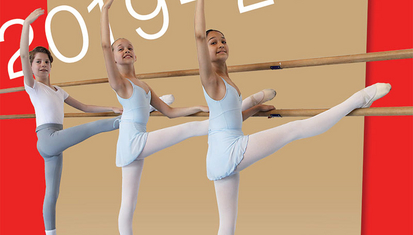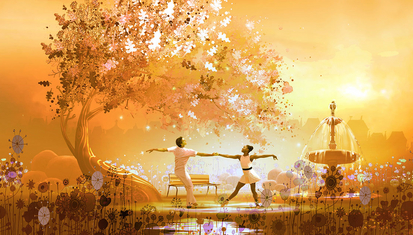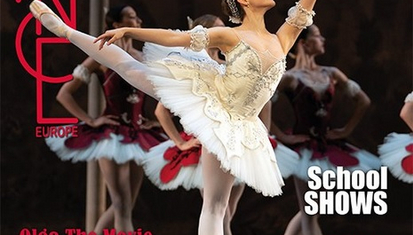In this new column, we will be spotlighting a teacher or other member of staff at the National Ballet Academy. This time, we speak to two people: Linda Witpaard and Wendy Tadrous-Paulusma, who have both recently joined the National Ballet Academy’s office team. Linda studied dramaturgy and scenography, and is combining her new position as ‘coordinator of projects and performances’ with her freelance work as an illustrator. Last summer, Wendy said goodbye to the stage following a long dancing career, and is now making her mark behind the scenes as an ‘education support assistant’.
Wendy and Ernst Meisner, artistic director of the National Ballet Academy, have known each other since they were four. Wendy (37): “We were in the same infant class in Lelystad. But at the time, I didn’t know that like me, he also went to ballet classes. We never talked about it at school, but we were both little ‘careerists’ and”, she says with a wink, “we’ve stayed that way too”.
From the age of ten, they travelled every day, along with a few other children from Lelystad and Almere, to the National Ballet Academy in Amsterdam, first at Agamemnonstraat, then for a while to the old building at Kerkstraat, and then to the new building at Jodenbreestraat. So Wendy is very familiar with her new work environment. She laughs, “At the time, the school at Jodenbreestraat was presented to us like a sort of Fame school. But unfortunately it was never as wild and high-spirited in our canteen as in the film”.
In 1999, Ernst transferred to The Royal Ballet School and was then accepted by The Royal Ballet. In 2000, Wendy started an apprenticeship with Dutch National Ballet. “But over the years, we’ve always stayed in touch”.
After a ‘wonderful time’ and eight years of ‘dancing all the roles within my range’, Wendy transferred to Ballett der Staatsoper, in Hannover, and four years later to Ballet du Rhin, in the French city of Mulhouse. “There, I had the opportunity to dance in more modern works: ballets by William Forsythe and Johan Inger, and maybe my favourite role of all, in David Pountney’s production of Kurt Weill’s opera Les Sept Péchés Capitaux (The Seven Deadly Sins). That was a role where I could experience every possible emotion in the space of half an hour”.
From 4D to 2D
For Linda (33), the connection with dance was less self-evident in the beginning. “I never took ballet classes as a child or did any other form of dance. It was only during my dramaturgy and scenography studies in Groningen that I came into contact with dance, through jobs on the side for dance company Club Guy & Roni and the choreographers’ platform Random Collision”.
After her studies, she moved to Amsterdam with the idea of creating her own productions on the interface between mime, dance and theatre. But through another job on the side, she soon encountered different challenges. “I was invited to become production manager with Dansmakers, and as a new inhabitant of Amsterdam in search of work in the theatre world, I could hardly say ‘no’ to a chance like that”, she laughs. After three years of doing mainly office production work, she missed being ‘on the floor’ herself, although after leaving Dansmakers and doing some shorter-term production jobs, she eventually chose another direction anyway. “I gradually came to realise that I could do my ‘thing’ best on paper – as a graphic artist and illustrator. So I made the switch from 4D to 2D, as it were, and alongside my autonomous work – which consists mainly of portraits – I now often create infographics and templates for businesses”.
At the same time, her ‘click’ with dance grew stronger. “The dance idiom means more to me now than I was aware of for many years. I still don’t know whether I’d choose dance over theatre, but what I like about dance is that the parameters are not so fixed. You’re much freer in experiencing dance, as it gives you plenty of space for you own interpretation of what you see. And I also really love the human side of the dance sector. ‘Dance people’ and I seem to speak the same language”.
Thrown in at the deep end
Five years ago, Linda van Bastian Manders, who then worked at the National Ballet Academy, was invited to take on the production of the International Summer School. “I rolled into it, did it for a couple of years, but then stopped at a certain point. Until Ernst called, asking if I could ‘please do one more edition’”.
The collaboration went so well that she is now working three days a week as ‘coordinator of projects and performances’ at the National Ballet Academy. “I like organising, and I can also combine this job well with my work as an illustrator”. And sometimes, the two come together. “For example, I made some drawings for the flyer for the Summer Dance Day”.
Her work for the National Ballet Academy takes place, she says, both front-of-house and backstage. “The Academy of Theatre and Dance has its own production department. We work with them closely on the backstage production of the performances, for which they are largely responsible. I’m also involved in projects like the Summer School, the boys’ course, the Teacher Seminars and the new Choreographic Project. I’m really enjoying the latter, because up to now I’ve had to deal mainly with children and students from outside the NBA, but now I have more intensive contact with our students as well”.
Wendy’s job is even more diverse, as far as that’s possible. She laughs, “I do everything that’s left over: doing the administration for the auditions, making contact with the education officer, arranging host families, taking minutes at meetings and anything else I can do to help Ernst and René (Vlemmix – ed.). Up to a couple of months ago, I had no office experience, so I was thrown in at the deep end, as it were. But I love challenges, I’m really happy with this opportunity and I’m learning on the job”.
Choreographic project
They both have a shared admiration for the young ballet pupils and students. Linda: “I think it’s wonderful to see that however young they are, they already know so clearly what they want and show such dedication in taking the necessary steps to achieve it”. Wendy: “For me, of course, seeing all those little faces brings back lots of memories too. Nice memories, because I had a really good time at the NBA myself. It’s also great to see teachers and pianists from those days again”.
However, they both think it’s important that pupils and students realise nowadays, maybe more so than previously, that there’s ‘more than just Dutch National Ballet’. Wendy: “Fortunately, much more attention is given to that now in talks with the children, and to the fact that they should look for the dance idiom they speak themselves”. Linda: “An initiative like the Choreographic Project also helps to stimulate that, challenging the students to investigate their own idiom, their own style and their own dance”.
Something to which Linda would like to contribute is familiarising students with everything that’s involved in creating a dance production. “I don’t know whether it would fit in the curriculum, but I think it would be good for them to learn more about what takes place behind the scenes, from lighting and scenery to budgets and marketing”. Wendy: “There are opportunities for that, too, in the Choreographic Project”.
Wendy is particularly enthusiastic about open communication. “I think it’s important that pupils, students and parents can get to speak to everyone in our organisation. And that it’s possible to talk about anything. So that nothing is taboo any longer”.
text: Astrid van Leeuwen


![[Translate to English:] [Translate to English:]](/media/the/_processed_/7/f/csm_jongenscursus_4a04002e7f.jpg)



